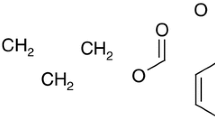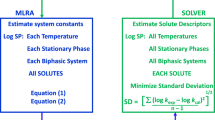We have analyzed the distribution coefficients (log P ow ) of organic compounds in the octanol-water system that were calculated by the k-nearest neighbors method on the basis of structural similarity and physicochemical descriptors [including the molecular polarizability (α), the sum of negative charges (ΣQ –), and the sum of donor (ΣCd) and acceptor ΣCa(0) factors] for models with 4, 3, and 2 descriptors and 10, 5, 3, and 1 neighbor. Calculations have been performed for eight subsets of structurally related compounds (selected from the main database containing 11,514 compounds) as well as for a combined set including these subsets (245 compounds). Distribution coefficients for each subset have been calculated based on the entire database (11,514 compounds) and databases for the composed set (245 compounds) and each subset. It is concluded that a two-parametric model including the descriptors α and ΣCa(0) ensures the most stable calculations. The separation of a narrow subset (domain) of compounds as the basis of calculations by the nearest neighbors method does not always improve the prediction of log P ow .
Similar content being viewed by others
References
R. Mannhold, in: Virtual ADMET Assessment in Target Selection and Maturation, B. Testa and L. Turski, eds., IOS Press, (2006), pp. 43 – 66.
O. A. Raevsky, K.-J. Schaper, and J. K. Seydel, Quant. Struct.-Act. Relat., 14, 433 – 436 (1995).
O. A. Raevsky, in: Computer-Assisted Lead Finding and Optimization Current Tolls for Medicinal Chemistry, H. van de Waterbeemd, B. Testa, and G. Folkers, eds., Wiley-VCH, Weinheim (1997), pp. 367 – 378.
O. A. Raevsky and V. Yu. Grigor’ev, Khim.-farm. Zh., 33(5), 46 – 49 (1999).
O. A. Raevsky, K.-J. Schaper, H. van de Waterbeemd, et al., in: Molecular Modelling and Prediction of Bioactivity, K. Gundertofe and F. Jorgensen, eds., Kluwer Academic / Plenum Publ., (2000), pp. 221 – 227.
O. A. Raevsky, E. P. Trepalina, and S. V. Trepalin, Khim.-farm. Zh., 34(1), 34 – 37 (2000).
O. A. Raevsky, SAR QSAR Environ. Res., 12, 367 – 381 (2001).
O. A. Raevsky, S. V. Trepalin, H. P. Trepalina, et al., J. Chem. Inf. Comput. Sci., 42, 540 – 549 (2001).
Patent No. 990,098, February 26, 1999; SLIPPER (Solubility, LIPophilicity, PERmeability).
I. V. Tetko and G. I. Poda, in: Molecular Drug Properties. Measurement and Prediction, R. Mannhold, ed.,Wiley-VCH Verlag GmbH & Co KGaA, Weinheim (2008), pp. 381 – 406.
Author information
Authors and Affiliations
Additional information
Translated from Khimiko-Farmatsevticheskii Zhurnal, Vol. 43, No. 5, pp. 28 – 32, May, 2009.
Rights and permissions
About this article
Cite this article
Andreeva, E.P., Raevsky, O.A. Lipophilicity of organic compounds calculated using structural similarity and molecular physicochemical descriptors. Pharm Chem J 43, 258–262 (2009). https://doi.org/10.1007/s11094-009-0280-5
Received:
Published:
Issue Date:
DOI: https://doi.org/10.1007/s11094-009-0280-5




